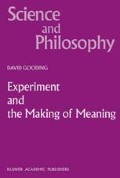Abstract
In chapter two I showed how aspects of new phenomena are made accessible to experience and how their given-ness in experience is also constructed through a process of representing, or construing. I argued that observers’ agency is essential both to eliciting experiential possibilities and to rendering them as observerable features of nature. Rendering includes the invention of frameworks of activity. These and the outcomes of activity understood in terms of them, were represented by images such as Biot’s ‘circular contour’ and Davy’s ‘chords’. Making images is just as creative an activity when practiced by scientists as when practiced by artists. Faraday’s mnemonics may lack the aesthetic appeal of Leonardo’s sketches, yet they did a very similar job: they conveyed, through an image, aspects of experience that had been (or was being) made sense of.1
Perception being such a private business, I find it ironical that the best evidence of what to count as perceptual should be social conformity. I shall not pause over the lesson, but there is surely one there.
W.V.O. Quine
Access this chapter
Tax calculation will be finalised at checkout
Purchases are for personal use only
Preview
Unable to display preview. Download preview PDF.
Notes
Wittgenstein (1953), para. 272.
Quine (1974), p. 37.
Cartwright (1983), p. 6, notes this obsession with entities, but she is concerned with theoretical concepts at a far greater remove from observational practices than the rudimentary notions considered here.
Wittgenstein (1953), para. 257.
See Bloor (1983), Collins (1985) and on the limitations of ostension as a model for experimental practice, Pickering, “Positivism, Holism, Constructivism”, unpublished Ms, 1987, and Pickering (1988, 1989).
Quine (1960), p. 270 ff.
For the distinction between peripheral and focal awareness see Polanyi (1964), pp. x, 55–57, 161–63.
Hesse (1974), p. 61. Gruber (1985), p. 179 also notes that in the shadow-box situation truth may become little more than consensus.
See, for example, the studies in Barnes and Shapin, eds., (1979).
Private communications; see also Pickering (1989), p. 290 ff.
Kuhn (1962b), p. 142.
Ravetz (1971), pp. 75–76.
See Polanyi (1964), pp. 49–66 and Kuhn’s discussion of exemplars in his ‘Postscript’ to Kuhn (1962b), reprinted in Kuhn (1977), pp. 297 ff.
Wittgenstein (1953), paras. 256–274. Winch’s version of this argument supports a more idealistic position than Wittgenstein’s (Winch 1958).
The instability of experience is one aspect of the problem of replication, though it is not not as intractable a problem as laboratory ethnographers sometimes suggest. Consistency of experience depends on skill in producing, representing and recording it. Davy’s dilemma — cited as the forword to chapter 2, presupposed such skills.
Gombrich (1980) p. 212. Poincaré made a similar point about experiment in his (1952), p. 140.
Wittgenstein (1953), paras. 94e-95e, 265.
See, e.g., Martin (1932–36), vol. 1, p. 58–9, discussed below.
This follows from a very narrow definition of what counts as discovery, as does the irrelevance of the pre-history of experiment; see Brannigan (1981).
Winch (1958), p. 86.
Ibid.
Gooding (1985c), pp. 167–70.
Tweney (1985).
Tweney, “The use of external memory in science”, unpublished Ms.
In an Address to the British Association Maxwell once asked ‘but who will lead me [from the molecular realm] into that still more hidden and dimmer region where Thought weds Fact, where the mental operations of the mathematician and the physical action of the molecules are seen in their true relation?’, Maxwell (1890), vol. 2, p. 216.
Construals are not the empirical ‘base’ of an hierarchical, theoretical structure. Here it is more useful to think of the temporal distance of the objectives of such activity as Galison does (in terms of problems that need to be solved in the short, medium and long-term) rather than the ‘level’ of abstraction or theoreticity of the models: Galison (1987).
For a variety of examples of processes of objectification or reification see: Fleck (1979), Ihde (1979), Latour and Woolgar (1979), Gooding (1982a) and Shapin and Schaffer (1985), especially their discussion (p. 17 & ff.) of Alpers (1983).
See Hacking (1983), part II. Agency in observation is also discussed in von Wright (1971), pp. 60–64.
Feyerabend (1975) and Hanson (1972).
See Putnam (1981), chapter 3 and Hesse (1974), pp. 56–59 for this problem.
For the assimilation of the world to representations of it see Rorty (1980), esp. chapters 4 and 6.
Putnam (1975), pp. 144–64.
Jardine (1978), pp. 119–20.
Putnam (1973), p. 203 ff.
This is because the transfer of tacit knowledge (Collins 1974, 1975) is a social process: Collins (1985).
Maxwell’s comments on the importance of Faraday’s lines of force are well known: see his preface to Maxwell (1873) and his article on Faraday in Maxwell (1890), vol. 2, pp. 359–60. Studies of the development of Faraday’s ideas tend to neglect Thomson’s important role (see Larmor, 1937); recent studies are: Heimann (1970), Nersessian (1984), Wise (1979).
For an account see Gooding (1981) and below, chapters 4 and 10.
For the context in which dissemination motivated demonstrations see Hays (1983) and Gooding (1985a, 1989a).
For finitism see Bloor (1983), p. 27.
Author information
Authors and Affiliations
Rights and permissions
Copyright information
© 1990 Kluwer Academic Publishers
About this chapter
Cite this chapter
Gooding, D. (1990). Making perception possible. In: Experiment and the Making of Meaning. Science and Philosophy, vol 5. Springer, Dordrecht. https://doi.org/10.1007/978-94-009-0707-2_3
Download citation
DOI: https://doi.org/10.1007/978-94-009-0707-2_3
Publisher Name: Springer, Dordrecht
Print ISBN: 978-0-7923-3253-4
Online ISBN: 978-94-009-0707-2
eBook Packages: Springer Book Archive

